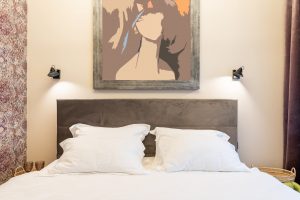How To Hang Artwork Correctly
 Hanging art can occasionally soften the pleasure of collecting. You would like your new painting to appear perfect, but you cannot find a wall stud, so you are having difficulties with your degree, and the framework is a whole lot heavier than you understood. We have been there, however, luckily, there are a few simple methods for hanging artwork that may make the entire process much, much easier.
Hanging art can occasionally soften the pleasure of collecting. You would like your new painting to appear perfect, but you cannot find a wall stud, so you are having difficulties with your degree, and the framework is a whole lot heavier than you understood. We have been there, however, luckily, there are a few simple methods for hanging artwork that may make the entire process much, much easier.
If you are uncertain about the perfect way to hang your artwork, these tips can enable you to transform your house into the artwork showcase of your dreams.
Decide on a pattern
The guideline is that art should be readily readable, irrespective of whether it is one work or several works hanging as a team. When hanging numerous artworks, pick a blueprint to follow. It can be a very simple grid that maximizes using a more natural design that fits your character. With almost any pattern, attempt to maintain the spacing between the artwork’s constant. To hang artwork, use a finish nailer. Check out this finish nailer review to know which one works best. Work inside the area
When hanging artwork, do your best not to put it too low or high on the wall. Think about the space it is hanging when deciding the ideal height – are individuals sitting down frequently or just walking. You would like the art at eye level. You wish to view it without moving your head down or up.
The normal eye level is all about 57 inches in the ground, so getting the middle of the artwork in this height – maybe not the best – is suggested.
When a space has multiple windows and doors, organize the art to line up with all the center of the frames rather than the top or underside.
Create a “rough draft” before hanging
Cut paper or kraft paper to templates that fit the size of this artwork and tape them into the wall with tape. This can provide you with a wonderful visual regarding how it will look before hanging your artwork without hammering a lot of unnecessary holes in your wall.
Another choice is to put out the artwork on the ground on your preferred pattern. In that way, you can have fun with the settings, see how they appear when put alongside another and decide their best arrangement.
Consider your color schemes and topics first
When selecting which functions to put collectively, picking out a color scheme and picking art based on that strategy. As a result, you may use different framing designs and maintain a uniform decoration. Art with neutral colors may also be blended to a bolder color scheme to supply some sort.
Match up distinct sizes
Substantial art is striking and makes a statement, and consequently needs space to be honored. Smaller art, on the other hand, is ideal for wall areas between windows and doors or developing a set to show together. When hanging art over furniture such as a couch or bed, ensure that the design is about a third of their furniture dimensions, since the art will otherwise seem odd in contrast. Again, keep it at eye level.
Produce a rotating gallery
If you have just run out of wall space, consider changing out the art occasionally. Who knows? Swapping out work for another may change the mood or sense of the space and supply a distinct atmosphere which may produce the art and your living room pop.



